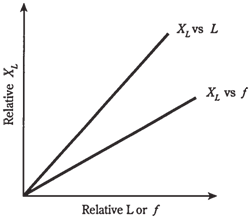Reactance and frequency:
Inductive reactance is one of the two kinds of reactance; the other, called as capacitive reactance, will be discussed in next chapter. Reactance in general can be symbolized by the capital letter X. Inductive reactance can be indicated by the letter X with the subscript L: XL.
If frequency of an alternating current source is given, in hertz, as f, and the inductance of the coil in henrys is L, then inductive reactance is
XL = 6 .28fL
The same formula applies if frequency, f, is in kilohertz and inductance, L, is in millihenrys. And it applies if f is in megahertz and L is in microhenrys. Just remember that if the frequency is in thousands, inductance should be in thousandths, and if the frequency is in millions, inductance should be in millionths.
Inductive reactance increases linearly with the increasing alternating current frequency. This means that function of XL vs f is a straight line when graphed. Inductive reactance increases linearly with the inductance. Thus, the function of XL vs L appears as a straight line on a graph. The value of XL is proportional to f; XL is also proportional to L. These relationships are graphed, in the relative form, in the figure given.
Problem:
Assume that a coil has an inductance of 0. 50 H, and frequency of the alternating current passing through it is 60 Hz. What do you understand by inductive reactance?
By using the above formula, XL = 6.28 * 60 * 0. 50 = 188.4 ohms. You should round this off to 2 significant digits, or 190 ohms, as the inductance and frequency are both expressed to 2 significant digits.

Figure-- Inductive reactance is directly proportional to inductance and to frequency.